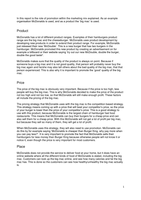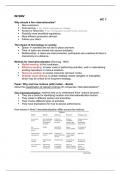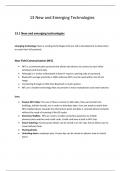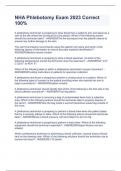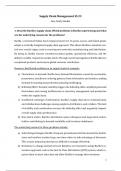Aantekeningen hoorcollege ‘Marketing’
,Lecture 1 (Chapter 1)
Marketing is everywhere. You are constantly marketed to. And you, yourself, do marketing
on a daily basis.
We all use marketing
You see a gorgeous girl at the party …
- Direct marketing: you say: ‘I am very rich. Marry me’
- Referral marketing (WOM): one of your friends hoes up to her and says: ‘He’s very
rich. Marry him’
- Advertising: you wear a shirt that says: ‘Marry me’
- Telemarketing: you get her telephone number, call her and say: ‘Hi, I’m very rich.
Marry me’
- Customer feedback: after you say: ‘I’m very rich. Marry me’, she gives you a hard
slap
- Restriction for entering new markets: your wife arrives you say: ‘I’m rich, marry
me’
The biggest myth about Marketing
Marketing is not advertising (but advertising is marketing). Areas of marketing: market
research, social media, SEO, content marketing, direct marketing, pricing, marketing strategy,
promotion, channel marketing, product design, branding.
The nature of marketing
Marketing is creating and communicating value to you customer. Marketing enables the
parties to engage in such exchanges and managers those exchanges to create value.
Definitions
AMA (2007): Marketing is the activity, set of institutions, and processes for creating,
communication, delivering, and exchanging offerings that have value for customers, clients,
partners and society at large.
Dibb et al. (2019): Marketing consists of individual and organizational activities that
facilitate and expedite satisfying exchange relationships in a dynamic environment through
the creation, distribution, promotion and pricing of goods, service and ideas.
Marketing for manufacturer
Value= profit = revenues – costs
Good profit= earned from creating value that leads to customer loyalty, repeat purchase,
cross/up-selling, positive WOM, etc.
Bad profit= earned at the customer’s expense.
Marketing for consumer
Value= benefits – sacrifices
Benefits= economic, function, psychological
Sacrifices= costs expected to incur when evaluating, obtaining, using and disposing of market
offerings (money, time, psychological costs, energy/ effort)
Marketing is complex
- Many consumers with a diversity of needs & wants
, - Identify and targets consumers whose needs are most consistent with your resources
and capabilities
o (internal & external) situational analysis
o Market segmentation, targeting and positioning
Place (distribution)
- Where and when should the exchange take place?
- Selecting, developing and managing distribution channels
- Challenges: channel conflict and channel hopping
Pricing decisions
- Setting prices
- Managing price perception
- Adapting prices
Promotion
Selecting communication means & content for the right customer at the right time.
, Lecture 2 (The Company and environment)
Why do companies have mission and vision statements?
- To help guide the different departments in a company (e.g., product development,
marketing, company culture)
- Without the mission/vision statement how will the company develop its offering to the
customer?
o It is like a ship with no destination
Examples
- Starbucks
o “To inspire and nurture the human spirit – one person, one cup and one
neighborhood at a time”
- McDonald’s
o “Our mission is to make delicious feel-good moments easy for everyone.”
- Spotify
o “Our mission is to unlock the potential of human creativity—by giving a
million creative artists the opportunity to live off their art and billions of fans
the opportunity to enjoy and be inspired by it.”
Why is this important? The
objectives, the strategy
- Helps direct the efforts a
company takes across its
offerings and market
- Ansoff’s Matrix (1988)
Voorbeeld Pepsi:
Market penetration: van een
kleiner flesje, naar een groter
flesje
Market development: pepsi
max maken
Product development: pepsi
cherry
Diversification: walkers, in a
new market
,Lecture 1 (Chapter 1)
Marketing is everywhere. You are constantly marketed to. And you, yourself, do marketing
on a daily basis.
We all use marketing
You see a gorgeous girl at the party …
- Direct marketing: you say: ‘I am very rich. Marry me’
- Referral marketing (WOM): one of your friends hoes up to her and says: ‘He’s very
rich. Marry him’
- Advertising: you wear a shirt that says: ‘Marry me’
- Telemarketing: you get her telephone number, call her and say: ‘Hi, I’m very rich.
Marry me’
- Customer feedback: after you say: ‘I’m very rich. Marry me’, she gives you a hard
slap
- Restriction for entering new markets: your wife arrives you say: ‘I’m rich, marry
me’
The biggest myth about Marketing
Marketing is not advertising (but advertising is marketing). Areas of marketing: market
research, social media, SEO, content marketing, direct marketing, pricing, marketing strategy,
promotion, channel marketing, product design, branding.
The nature of marketing
Marketing is creating and communicating value to you customer. Marketing enables the
parties to engage in such exchanges and managers those exchanges to create value.
Definitions
AMA (2007): Marketing is the activity, set of institutions, and processes for creating,
communication, delivering, and exchanging offerings that have value for customers, clients,
partners and society at large.
Dibb et al. (2019): Marketing consists of individual and organizational activities that
facilitate and expedite satisfying exchange relationships in a dynamic environment through
the creation, distribution, promotion and pricing of goods, service and ideas.
Marketing for manufacturer
Value= profit = revenues – costs
Good profit= earned from creating value that leads to customer loyalty, repeat purchase,
cross/up-selling, positive WOM, etc.
Bad profit= earned at the customer’s expense.
Marketing for consumer
Value= benefits – sacrifices
Benefits= economic, function, psychological
Sacrifices= costs expected to incur when evaluating, obtaining, using and disposing of market
offerings (money, time, psychological costs, energy/ effort)
Marketing is complex
- Many consumers with a diversity of needs & wants
, - Identify and targets consumers whose needs are most consistent with your resources
and capabilities
o (internal & external) situational analysis
o Market segmentation, targeting and positioning
Place (distribution)
- Where and when should the exchange take place?
- Selecting, developing and managing distribution channels
- Challenges: channel conflict and channel hopping
Pricing decisions
- Setting prices
- Managing price perception
- Adapting prices
Promotion
Selecting communication means & content for the right customer at the right time.
, Lecture 2 (The Company and environment)
Why do companies have mission and vision statements?
- To help guide the different departments in a company (e.g., product development,
marketing, company culture)
- Without the mission/vision statement how will the company develop its offering to the
customer?
o It is like a ship with no destination
Examples
- Starbucks
o “To inspire and nurture the human spirit – one person, one cup and one
neighborhood at a time”
- McDonald’s
o “Our mission is to make delicious feel-good moments easy for everyone.”
- Spotify
o “Our mission is to unlock the potential of human creativity—by giving a
million creative artists the opportunity to live off their art and billions of fans
the opportunity to enjoy and be inspired by it.”
Why is this important? The
objectives, the strategy
- Helps direct the efforts a
company takes across its
offerings and market
- Ansoff’s Matrix (1988)
Voorbeeld Pepsi:
Market penetration: van een
kleiner flesje, naar een groter
flesje
Market development: pepsi
max maken
Product development: pepsi
cherry
Diversification: walkers, in a
new market


